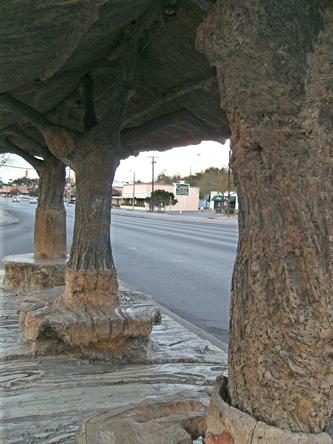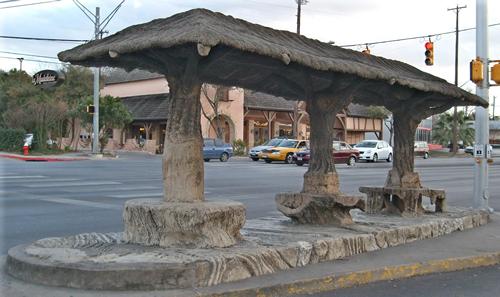|
|
Fernridge, the
former Brackenridge Estate has been preserved on the campus of Incarnate
Word College as a museum.
Photo courtesy Sarah
Reveley, February 2007 |
History in
a Pecan Shell
Once a campground for Indians (within present-day Brackenridge Park),
the headwaters of the San Antonio River begin here on the grounds
of Cathedral House. Alamo Heights was included in the original survey
of the city of San Antonio
in 1836. The following year a city ordinance autioned off city land
to fund city improvements and infrastructure.
Although it was bitterly contested, the site was sold and was eventually
bought in 1869 by Mrs. Isabel Brackenridge. Her famous son, George
W. Brackenbridge sold the family estate in 1897 to the Sisters
of Charity of the Incarnate Word.
The former Brackenridge Family estate, Fernridge, is maintained as
a museum by the sisters.
Incarnate Word College sits on the line that divides San
Antonio and Alamo Heights.
The Argyle Hotel, another local landmark, was originally a ranch headquarters,
built by Charles Anderson in 1860. After undergoing several sales,
the land was eventually developed.
In the early 1920s, the city of San
Antonio vigorously tried to annex the Heights, but failed. In
1922 Alamo Heights became an independent municipality.
The population reached 7,950 by 1950 and declining to 6,933 for the
1970 census and returning over 7,000 mark to 2000’s 7,319.
Book Hotel Here › San
Antonio Hotels |
Brackenridge
Estate on Incarnate Word Campus
Photos
courtesy Sarah
Reveley, February 2007 |
| The statue was
purchased around 1900 by George
Brackenridge to be the garden centerpiece for the family estate.
|
|
The former Mobil
station on the corner of Broadway and Austin Highway has always
been a landmark. It was one of four built north, east, west and
south of downtown by the Magnolia Oil Company. When the gas station
went out of business the famous Flying Horse was saved, and the
location has been leased by a number of different businesses, including
a florist, realtor and a interior design company.
|
Alamo
Heights Trolley Stop
Photos
courtesy Sarah
Reveley, February 2007 |

|
The
Broadway / Patterson Street Bus Stop
Artist: Dionico Rodriquez
(1891-1955)
Called San Antonio’s “most accessable work of art” by Mark Rybczyk,
author of San Antonio Uncovered, this unusual structure was a gift
of the Alamo Cement Company to the city of Alamo Heights in 1931.
Dr.
Aureliano Urrutia employed Rodriquez at his estate and it was
the doctor who introduced him to Chas. Baumberger Sr., who founded
Alamo Cement.
The Gate to the Chinese Sunken Garden in Brackenridge Park was also
a work by Rodriquez as well as a fish pond / fountain and fence
at the Alamo Cement Company headquarters.
Rodriquez’ tool of choice was a simple dining fork and his medium
was cement. The process was kept a secret, that some say died with
the artist in 1955.
Dionico Rodriquez worked where his commissions took him. From Mexico
City to New York City and some out-of-the-way places (Hot Springs,
Arkansas and Memphis, Tennessee) between those two monumental bookends.
The trolley / bus stop is now listed on the National Register of
Historic Places.
Related content
that includes more on the Alamo Cement Company and the work of Dionico
Rodriquez, please see Cementville,
Texas
Forum:
Re-the trolley stop by Rodriguez-he also did work on the old mill
in North Little Rock Arkansas-which is in the opening scene of "Gone
with the Wind." - George Pecan, April 23, 2008
|
 |
|
The Trolly Stop
today
(February
2007 photo)
|
| The Trolly Stop
20 years ago |
More
Alamo Heights Scenes
Photos
courtesy Sarah
Reveley, February 2007 |
| The
Broadway Theatre was turned into an office building 25 years ago,
but the sign remains as a local landmark across from the trolley stop.
|
|
Alamo
Heights is filled with charming bungalows, and an effort for a Historic
District classification is currently underway.
Photos courtesy Sarah
Reveley, February 2007.
|
|
A
seated statue of George Brackenridge
is displayed at the entrance to Brackenridge Park at Funston Place
at 3501 Broadway. Designed in the 1930s, it sat as a plaster model
for years. After Pompeo Coppini’s death his adopted daughter, sculptress
Waldine Tauch got permission from the mayor of San
Antonio to cast the statue, and it was sent to Italy. A controversy
over the contract not being signed resulted in Tauch getting stuck
with the $30,000 bill. Funds were raised and in 1970, the statue
was finally set in place.
Information from A Comprehensive Guide to Outdoor Sculpture in
Texas by Carol Morris Little.
See Statues
in Texas
|
|
| Texas
Escapes, in its purpose to preserve historic, endangered and vanishing
Texas, asks that anyone wishing to share their local history, stories,
landmarks and vintage/historic photos, please contact
us. |
|
|


 Texas
Gulf Coast
Texas
Gulf Coast East
Texas
East
Texas Central
Texas North
Central
Texas North Central
Texas South
Central
Texas South Texas
Panhandle
Texas
Panhandle South
Texas
South
Texas Texas
Hill Country
Texas
Hill Country West
Texas
West
Texas Texas
Ghost Towns
Texas
Ghost Towns Texas
Counties
Texas
Counties